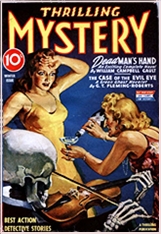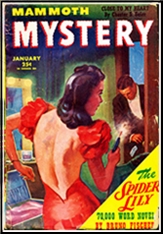Mon 2 Oct 2023
Pulp Stories I’m Reading, Selected by Mike Tooney: Two by A. BOYD CORRELL.
Posted by Steve under Pulp Fiction , Stories I'm Reading[6] Comments
A(UGUSTUS) BOYD CORRELL, according to FictionMags, was “born in South Carolina; Newspaperman, writer for Walt Disney, author of magazine short stories; died in Los Angeles.” In 1948 he co-authored a novel, The Dark Wheel (a.k.a. Sweet and Deadly), with Philip MacDonald.
Correll specialized in short crime fiction, however, with his over two dozen stories being placed in the major detective pulps of the ’40s and ’50s; in the ’60s he generated two episodes for Robert Taylor’s Detectives TV series, and the ISFDb credits him with three works of SFF (Science Fiction-Fantasy). Although we’re sure more of his stories are lurking out there somewhere on the Internet, for the moment we can locate only two of them, both of which are, not surprisingly, movie-related.
(1) “The Corpse That Played Dead” (Thrilling Mystery, Winter 1943) Online here.

Film actor Ronald Edwards’s movies always lose money, so why does Panamint Studios boss Emil Friml keep making films with Edwards in them? For Friml, the main concern is that somebody is trying to kill Edwards while he’s making a war movie, falling sandbags and flame-throwers blasting real flames at his leading man. This is enough for Friml to call in the studio’s unofficial detective, Jimmy Lee, our first-person narrator. In spite of Lee’s presence right there on the sound stage, though, someone succeeds in doing Edwards in just as they’re filming a battle scene on a bridge:
“As I started for the door, the background lights, casting their eerie glow of red, suddenly blinked out. The stage was in total darkness. I let out a yelp of surprise and was smacked flat as someone rushed past me. Jane screamed — a long, piercing cry that echoed and reechoed through the building.
“I heard a thumping as I pushed to my feet and held my hands out to avoid another collision. There was a swishing, grating noise as though a body were being dragged across the floor, then a bump — and silence. . .
“I started, when I glanced at the spot where the corpse had been. The body was gone.”
Lee doesn’t realize it at the time, but the apparently pointless act of the body being dragged across the floor is the key that will unlock how — and who — murdered failed matinee idol Ronald Edwards.
Here’s a nice bit of descriptive writing that also serves to delineate the character of the studio boss:
(2) “Death on Location” (Mammoth Mystery, January 1946). Online here.

Tom Ferguson’s normal occupation is scouting for movie locations, but when he embarked on this particular expedition he never anticipated finding an old woman with her throat torn out — or getting attacked by a swamp monster that walks on two legs (a “gibbering thing that smelled of putrefied flesh”), a creature straight out of a nightmare that, oddly, seems a mite too protective, not of its territory per se, but of some small shiny, round things that your average monster wouldn’t think twice about, but which would definitely excite human interest, enough human interest to lead to murder . . .
October 2nd, 2023 at 9:27 pm
From the FictionMags Index:
Correll, A(ugustus) Boyd (1905-1987)
* Blackmail, Theft and Murder, Inc., (ss) Black Mask March 1941
* A Book Is Lost, (ss) Street & Smith’s Detective Story Magazine July 1944
* Case of the Wanton Cadavers, (ss) Detective Short Stories July 1942
* The Corpse That Played Dead, (ss) Thrilling Mystery Winter 1943
* Death in the Studio, (nv) Street & Smith’s Detective Story Magazine May 1945
* Death Invites an Audience, (ss) Dime Detective Magazine May 1945
* Death on Location, (ss) Mammoth Mystery January 1946
* Death Strikes a Discord, (ss) The Phantom Detective December 1943
* Death Takes a Partner, (ss) Street & Smith’s Detective Story Magazine November 1946
* Family Affair, (ss) 5 Detective Novels Magazine Winter 1950
* Hollywood Homicide, (ss) Street & Smith’s Detective Story Magazine May 1946
* Homicidal Holiday, (ss) Popular Detective August 1942
* Homicide Set to Music, (nv) Detective Fiction January 24 1942
* The House of Lost Men, (ss) New Detective Magazine November 1943
* An Item of Murder, (ss) Street & Smith’s Detective Story Magazine July 1945
* Lethal Legacy, (ss) Dime Detective Magazine April 1946
* Murder Ad Lib, (ss) Street & Smith’s Detective Story Magazine April 1946
* Murder in Act II, (nv) Street & Smith’s Detective Story Magazine March 1945
* Murder Rehearsal, (nv) Street & Smith’s Detective Story Magazine October 1946
* Murder Resurrects the Dead, (ss) 10 Story Mystery Magazine (Canada) September 1943
* Press Agent for Murder, (ss) Street & Smith’s Detective Story Magazine August 1945 [Best Detective Stories of the Year ed. David C. Cooke, Dutton, 1946]
* Roses Are for Murder, (ss) New Detective Magazine July 1943
* The Shamus Called It Murder, (ss) Black Mask August 1941
* The Shrine, (nv) Street & Smith’s Detective Story Magazine April 1947
* Somebody Will Dance with Death, (ss) Detective Short Stories October 1943
* The Spell of Death, (ss) Thrilling Mystery Fall 1944
* The Unsuspecting Die, (ss) Street & Smith’s Detective Story Magazine December 1945
* [letter from West Hollywood, CA], (lt) Weird Tales May 1936
October 3rd, 2023 at 9:53 am
He also wrote Murder Is an Art, a 1950 Phoenix Press novel featuring PI Jerry Oliver.
October 3rd, 2023 at 11:10 am
Oops, almost let that one slip away. Thanks, Jim! One wonders how he and Philip MacDonald hooked up for the book they wrote togetherr, as mentioned in Mike’s first paragraph.
There might be an interesting story there.
October 3rd, 2023 at 3:04 pm
Although Correll doesn’t have any screenwriting credits in the Internet Movie Database except forr The Detectives, a lot of his stories have titles associated with moviemaking, and MacDonald was a screenwriter, so maybe there’s a Hollywood connection.
October 3rd, 2023 at 8:12 pm
Jim
I think you have the truth of it. MacDonald was working on the book and needed some Hollywood insider to provide some inside stuff. A friend of a friend said call Correll, He’s a writer and he’ll know.
October 4th, 2023 at 7:29 pm
MacDonald by then was a Hollywood studio type himself and had been since the 1930’s when he was writing Charlie Chan and Mr. Moto films. Most likely MacDonald generated the plot and the characters and farmed it out to Correll to write it, possibly without ever meeting him. Assuming the two men knew each other for the collaboration may be a false starting point.
MacDonald may have been busy and needed to fulfill a contrac or had an idea he just didn’t want to carry all the way himself. Maybe they shared an agent.
As for Correll at that time when the studios were still around the lack of credits did not mean lack of work. Max Brand has relatively few credits as a screenwriter, but was the highest paid writer in Hollywood as a screen doctor who worked on numerous films he did not sign his name to. There were screenwriters who had quite financially profitable careers and never have a single film produced with their names on it.